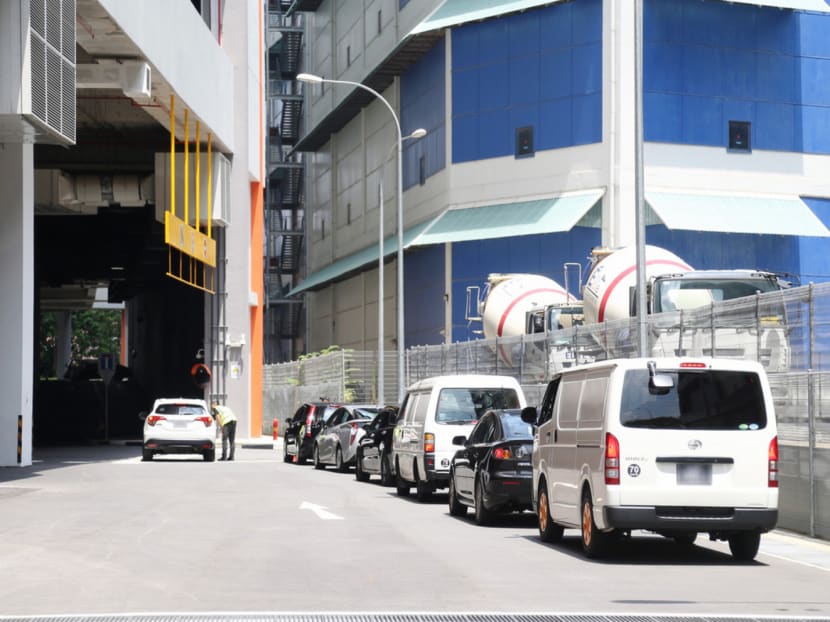Amazon’s strategy: Fast delivery first, profits later
SINGAPORE — E-commerce giant Amazon’s move to pay drivers here up to S$30 an hour to deliver goods ordered through its Amazon Prime Now service may not make much business sense at first glance, but it is a tactic the company has adopted in many countries for years.

Cars and vans waiting to receive delivery orders for Amazon’s Prime Now goods last week, after the company launched its app in Singapore. The e-commerce giant is paying drivers here up to S$30 a hour to deliver goods. Photo: Koh Mui Fong
SINGAPORE — E-commerce giant Amazon’s move to pay drivers here up to S$30 an hour to deliver goods ordered through its Amazon Prime Now service may not make much business sense at first glance, but it is a tactic the company has adopted in many countries for years.
The strategy of the world’s largest online retailer is premised on cheap and fast delivery, regardless of the impact on its bottom line, parlaying its reputation as an efficient and low-cost logistics operator into generating growth and customer loyalty.
When it launched Amazon Prime in the United States in February 2005, it changed the e-commerce delivery scene by pledging to deliver customers’ purchases with fast “free” two-day shipping for an annual fee of US$99 (S$134.50).
Previously, packages took at least a week to reach customers and those who wanted them quickly would have had to cough up a lot to courier companies like FedEx or DHL.
“We really wanted to make it easy for customers — the idea of, ‘make the decision once, and then for the year, you don’t have to think about it’,” Amazon Prime’s vice-president Greg Greeley told Fortune magazine in 2015.
To achieve its promise of fast, efficient delivery and reducing third-party delivery costs, Amazon built sorting centres in the US for nearby small parcel shipping.
The move allowed the company to use the more economical US Postal Service, saving it millions of dollars.
It has also built Amazon Prime hubs in the US to ensure it meets its one- and two-hour delivery targets, and since 2015, it has built over 60 of them, according to a Quartz report, with most located near high-density urban areas where its customers reside.
To cut shipping costs further, the US giant introduced 40 aircraft last year to deliver its own goods from its warehouses, reducing its dependency on third-party shippers.
Amazon CEO Jeff Bezos wanted to use drones to deliver goods, noting that they could cut down delivery time to 30 minutes or less.
The company made its first delivery by drone in Britain in December last year, during a trial in which the a TV streaming stick and bag of popcorn were delivered to a customer.
Over the years, Amazon has expanded internationally and now operates in Canada, Mexico, Britain, France, Germany, Japan, Italy, Spain, the Netherlands, Ireland, India and Singapore, with plans to move into the Middle East by acquiring Dubai-based Souq.com.
In India, where e-commerce sales reached US$14 billion last year, Amazon has pledged to spend US$5 billion in the next few years to expand its operations.
It has invested heavily in warehouses in the Indian states of Telangana, Haryana, Maharashtra, Madhya Pradesh, Uttar Pradesh and Andhra Pradesh so that it can reducing cost and time for deliveries in these areas.
The company has also set up its own delivery arm, Amazon Transportation Services (ATS), which not only delivers goods from Amazon’s warehouses but also offers logistical services to other businesses.
While Amazon is prepared to invest billions to improve its delivery services, it is also constantly looking at how to trim shipping costs, which amounted globally to more than US$8 billion in 2015.
In China, the company has cut out middlemen who deliver goods from warehouses to seaports by performing the role in-house. Last year, it announced that it was leasing 20 Boeing 767s to deliver its own goods to and from its fulfilment centres in the US.
With business consultancy Frost & Sullivan projecting online retail sales in South-east Asia to more than quadruple to US$71 billion by 2021 from US$16 billion last year, Amazon has now cast its eye on this potentially lucrative market.
Amazon’s profit shrank in the second quarter of this year despite surging sales. Net sales increased 25 per cent to US$38 billion when compared with the same period last year, but profit plunged 77 per cent from a year ago to US$197 million.
Investments, depreciation of equipment, share buys and other expenses ate into revenue in a familiar pattern of Amazon putting long-term growth ahead of short-term profit.
“As good as Amazon is at generating sales, it is far less successful in turning those sales into profits,” GlobalData Retail managing director Neil Saunders said in a note commenting on the earnings.
“To be fair, much of this is deliberate: Amazon chooses to reinvest in its business and to sacrifice profits to boost its market share and dominance.” AGENCIES






